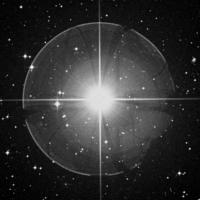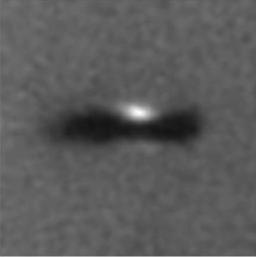Hubble Space Telescope Images of Proto-Planetary Disks
 Sounds like a nice theory, but is there any direct evidence that planetary
systems form in this way? A resounding YES.
Sounds like a nice theory, but is there any direct evidence that planetary
systems form in this way? A resounding YES.
Beta Pic Stars
Proto-planetary disks have been seen for over a decade.
First, stars known as Beta Pic stars, for their proto-type,
Beta Pictoris, were known to have excess infrared radiation.
The star, shown to the right, looks like any other star.
However, if you block out the bright stellar light, we see emission from a flattened disk (false color image, where red then white means stronger radiation). The scale on top shows that the disk has a size similar to our outer solar system.

Orion Protoplanetary Disks
 Sometimes nature can do the work for us. Toward the very young cluster
of Orion, young stars and proto-stellar systems are abundant. Because
the cluster is nearby, the spatial scale allows us to view objects about
the size of typical solar systems. Even with the knowledge astronomers
had from studying Beta Pic stars, and theories on planetary formation,
no one had expected to see such explicit images of disks as was seen by
Hubble in the Orion Star Cluster.
Sometimes nature can do the work for us. Toward the very young cluster
of Orion, young stars and proto-stellar systems are abundant. Because
the cluster is nearby, the spatial scale allows us to view objects about
the size of typical solar systems. Even with the knowledge astronomers
had from studying Beta Pic stars, and theories on planetary formation,
no one had expected to see such explicit images of disks as was seen by
Hubble in the Orion Star Cluster.
The star at the center is seen as bright (white) while the slightly flared disk of material, is seen edge-on. The proto-planetary disk surrounds the young star, blocking its light and making a dark patch across it.